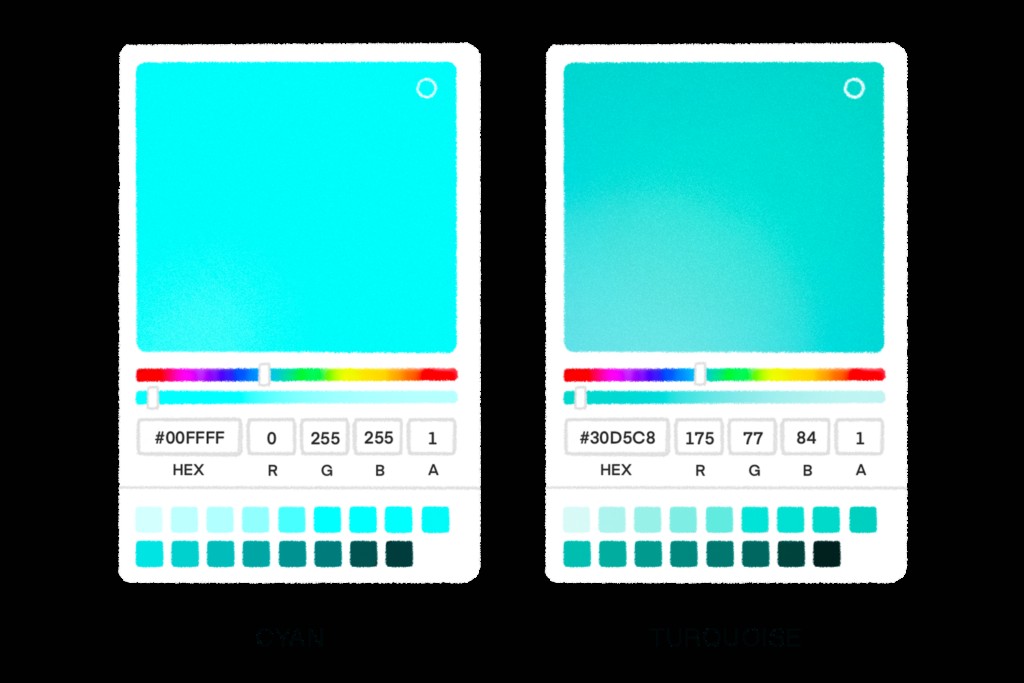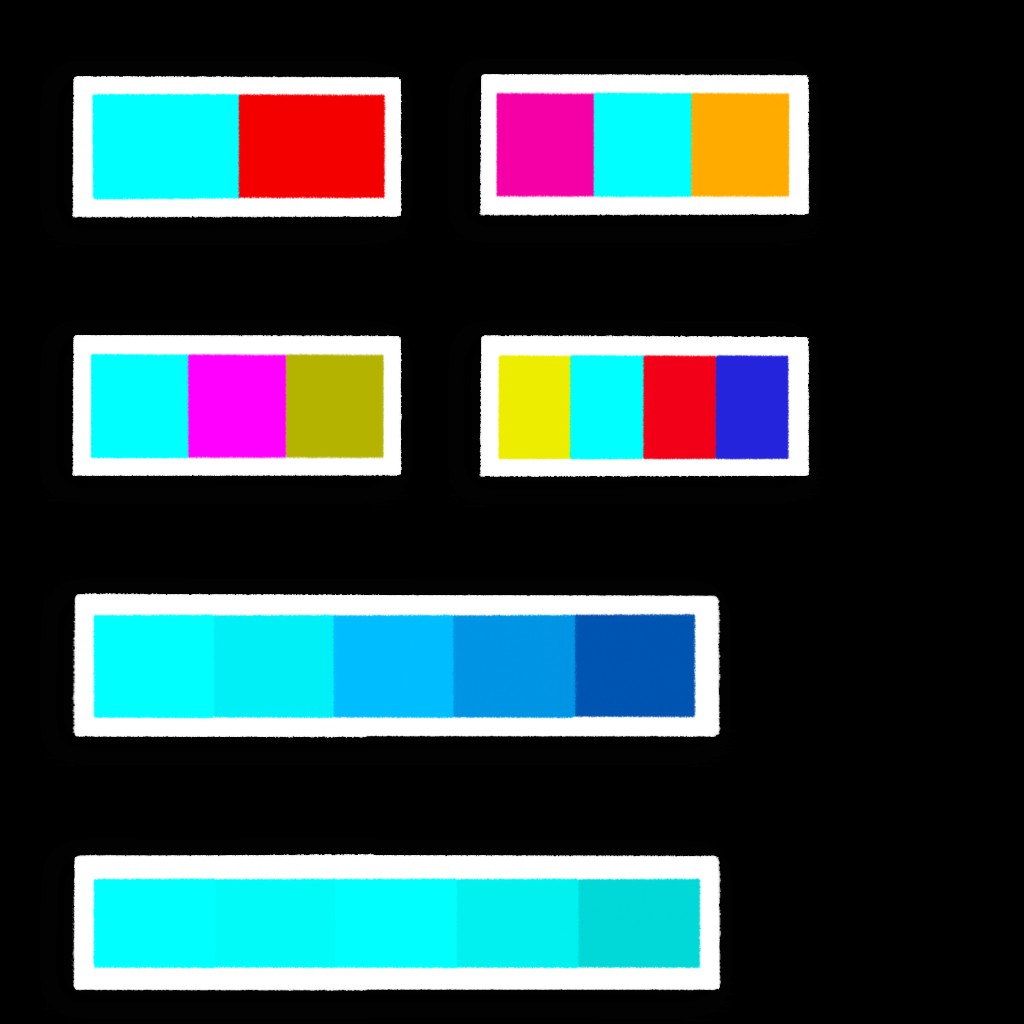Cyan is a vibrant color, and understanding its nuances is key. At WHAT.EDU.VN, we’re here to help you explore its definition, symbolism, and usage. Let’s dive into this colorful topic and discover its impact on design and beyond, exploring various shades and color combinations to expand your knowledge of color theory.
1. What Exactly Is Cyan Color?
Cyan is a bright, lively blue-green color that exudes vitality, youth, and energy. It’s often used in design and sometimes used interchangeably with turquoise, although they are distinct. Cyan’s hex code is #00FFFF, meaning it comprises 0% red, 100% green, and 100% blue in the RGB color model.
Cyan’s striking appearance makes it ideal for creating visually appealing designs. Whether you’re working on a website, logo, or marketing material, cyan can help you capture attention and leave a lasting impression. Want to learn more about how to use cyan effectively? Ask your questions for free on WHAT.EDU.VN.
2. Cyan vs. Turquoise: What’s the Difference?
While designers often use cyan and turquoise interchangeably, they are not exactly the same color. The primary difference lies in their composition. Cyan is a pure color found between blue and green on the visible light spectrum and is a primary color in the subtractive (CMYK) color model. Turquoise, on the other hand, is a mineral, an opaque, blue-to-green hydrous phosphate of copper and aluminum.
2.1. Cyan Color Information in Detail
Cyan falls between green and blue on the visible light spectrum. It is produced by light with a predominant wavelength between 490 and 520 nm. Along with magenta and yellow, cyan is one of the primary colors in the CMYK color model, essential for color printing. In the additive RGB color model, cyan is created by combining equal amounts of green and blue light.
Cyan is the complement of red, meaning it can be created by subtracting red from gray. This complementary relationship makes cyan a versatile color in design, as it can be used to create contrast and balance with red tones. Curious about how to use cyan in your next project? Get free advice on WHAT.EDU.VN.
2.2. Understanding RGB vs. CMYK Color Spaces
It’s crucial to understand the difference between RGB and CMYK color spaces to use cyan effectively.
- RGB (Red, Green, Blue): This color space is used for digital displays. In RGB, hex #00FFFF (cyan) is made of 0% red, 100% green, and 100% blue.
- CMYK (Cyan, Magenta, Yellow, Black): This color space is used for color printing. In CMYK, hex #00FFFF (cyan) is made of 100% cyan, 0% magenta, 0% yellow, and 0% black.
If you’re working on a digital project, use RGB values. For print projects, use CMYK values. This ensures that the colors you see on your screen accurately translate to the printed result. Need help with color conversions? WHAT.EDU.VN offers free support.
2.3. The Psychological Effects of Cyan and Turquoise
Both turquoise and cyan are known to promote peaceful, calm behavior and encourage rational, clear thinking, thoughtfulness, cleanliness, and emotional control. These colors can be particularly effective in environments where focus and tranquility are desired.
3. What Associations Does Turquoise Color Carry?
Turquoise is a blue-green color, encompassing a wide range of shades between blue and green on the color wheel. The name “turquoise” comes from the French phrase “pierre tourques,” meaning Turkish stone.
Throughout history, turquoise has represented various concepts, including water, the sky, and the sea. It is often associated with tranquility, serenity, happiness, and friendliness. Turquoise combines the tranquility of blue, the growth of green, and the energy of yellow, making it a versatile and emotionally resonant color.
3.1. Detailed Turquoise Color Information
Turquoise is a mix of pale blue and green or blue with a small amount of yellow. Its hex code is #30D5C8.
- RGB: In an RGB color space, hex #30D5C8 is made of 18.8% red, 83.5% green, and 78.4% blue.
- CMYK: In a CMYK color space, hex #30D5C8 is made of 77% cyan, 0% magenta, 6% yellow, and 16% black.
4. What Does Cyan Color Symbolize?
Colors evoke different emotions and associations. Warm colors (red, orange, yellow) can evoke feelings of warmth, comfort, anger, or hostility. Cold colors (blue, purple, green) can evoke feelings of peace or indifference.
Cyan, as a blend of blue and green, is a relaxing and inspiring color. It evokes images of crystal waters and is associated with liveliness, tranquility, youth, and energy. Cyan represents rationality and cleanliness.
5. How Many Different Shades of Cyan Exist?
There are many shades of cyan, each with unique characteristics. Here are twelve notable shades:
- Light Cyan (#E0FFFF)
- Aqua (#00FFFF)
- Aquamarine
- Medium Aquamarine
- Pale Turquoise
- Turquoise
- Medium Turquoise
- Dark Turquoise
- Light Sea Green
- Cadet Blue
- Dark Cyan (#008B8B)
- Teal
6. How Do You Effectively Combine and Use Cyan Color?
To achieve beautiful results, you need to know how to pair cyan with other colors effectively.
Cyan works well with its complementary color, red. It can also be combined with bold yellow and magenta, two other subtractive color model colors. For a more conservative color palette, combine cyan with darker blue shades or cool grays and whites.
6.1. Color Scheme Considerations
Choosing a color scheme involves more than just aesthetics. Understanding color science and psychology can guide your color choices and amplify your message. Use cyan when you want to liven up your creations, tone down a theme, spice up a background, brighten a mood, or project excitement.
6.2. Hue Variations and Their Meanings
Each hue carries its unique meaning and evokes specific feelings and thoughts. Variations of cyan include:
- Blue: Hex #0000FF
- Green: Hex #00FF00
- Blue-Green: Hex #0D98BA
6.3. Suggested Color Combinations with Cyan
- Purple
- Yellow
- Pink
6.4. Cyan Color Alternatives
Looking for a cyan alternative? Consider these options:
- Teal
- Aquamarine
- Turquoise
- Electric Blue
- Other blue-green shades
7. FAQs About Cyan
| Question | Answer |
|---|---|
| What is the hex code for cyan? | The hex code for cyan is #00FFFF. |
| Is cyan a warm or cool color? | Cyan is considered a cool color because it falls between blue and green on the color wheel. |
| What emotions does cyan evoke? | Cyan typically evokes feelings of tranquility, youth, energy, and cleanliness. |
| What colors go well with cyan? | Cyan pairs well with red (its complementary color), yellow, magenta, darker blue shades, and cool grays. |
| Can cyan be used in branding? | Yes, cyan is often used in branding to convey a sense of innovation, technology, and freshness. |
| What industries use cyan in their branding? | Industries such as technology, healthcare, and environmental organizations often use cyan to project trustworthiness and modernity. |
| How can I create cyan in paint? | To create cyan in paint, mix equal parts of blue and green. You may need to adjust the ratios to achieve the exact shade you desire. |
| Is cyan the same as aqua? | Cyan and aqua are often used interchangeably, but they can vary slightly. Both are blue-green colors, but cyan is typically a purer, more vibrant version. |
| What is the CMYK value of cyan? | The CMYK value of cyan is 100% cyan, 0% magenta, 0% yellow, and 0% black. |
| How does cyan appear on different screens? | Cyan can appear differently depending on the screen’s calibration. It’s essential to calibrate your screen to ensure accurate color representation in your designs. |


8. Dive Deeper into Color Knowledge
Understanding cyan and its applications can significantly enhance your design projects. Remember, the key to effective design is not just about choosing colors but understanding their meanings and how they interact with each other.
Do you have more questions about color theory, design, or anything else? Don’t hesitate to ask on WHAT.EDU.VN. Our community of experts is ready to provide you with free, accurate answers to help you succeed.
9. Ready to Ask Your Questions?
Still have questions about cyan or other topics? Don’t struggle with unanswered questions. At WHAT.EDU.VN, we provide a free and easy platform to ask any question you have. Our community of knowledgeable experts is ready to provide you with accurate and helpful answers.
Here’s how we address your challenges:
- Quick, Free Answers: Get the information you need without any cost.
- Expert Advice: Our community includes professionals and enthusiasts from various fields.
- Easy-to-Use Platform: Simply ask your question and receive prompt responses.
Stop wondering and start learning. Visit WHAT.EDU.VN today and ask your question for free.
10. Need More Help? Contact Us!
If you have further questions or need personalized assistance, don’t hesitate to reach out. We’re here to help you find the answers you need quickly and easily.
Contact Information:
- Address: 888 Question City Plaza, Seattle, WA 98101, United States
- WhatsApp: +1 (206) 555-7890
- Website: WHAT.EDU.VN
At what.edu.vn, we are committed to providing you with the best free question-and-answer service available. Ask away, and let us help you on your journey to knowledge!
